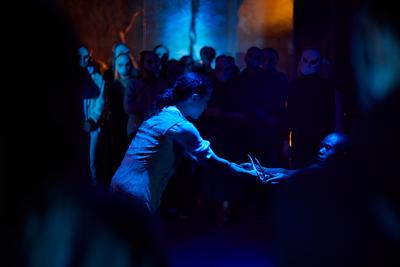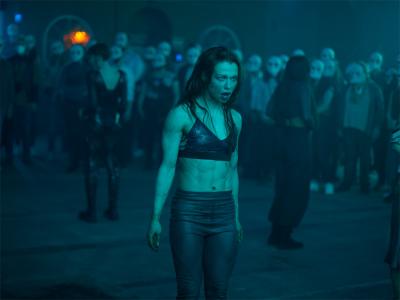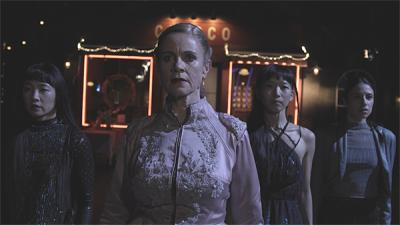In a time of increasingly technology-centered entertainment, from projections and video design to virtual reality and gaming, the British theatre company Punchdrunk is still surrounding audiences with mesmerizing, beautiful environments with which they can interact. Formed in 2000, Punchdrunk was one of the first companies to create immersive live experiences, trusting key decisions about what to focus on to the audience, and allowing it free rein to wander through minutely detailed worlds so that each ticket holder had a unique experience.
Trust is a huge part of the Punchdrunk experience. The audience is essentially on stage, choosing which performances to experience and walking through custom-designed rooms, most often created in large industrial spaces. There is no backstage, so staging a show walks a fine line between creating an authentic place where audience members will view, and sometimes touch, props up close, and protecting the environment for each new audience. Although the company is based in London, Punchdrunk shows have appealed to audiences around the world, including long-term engagements in Shanghai and New York.
Live Design talked to Punchdrunk associate creative director Livi Vaughan about the latest show, The Burnt City; her career with the company; and tips for theatre students who want to break in to the business.
Live Design: You began your career with Punchdrunk straight out of Central St Martins, University of the Arts in London. How did that happen?
Livi Vaughan: I started working with Punchdrunk when I was actually still at college. There was an ad on the Arts Council website looking for volunteers for a show they were making and I went down with a friend to volunteer on The Firebird Ball. It was fantastic because at that time the company was so small and really immediate—we were making decisions and choosing things. It felt really free. I met Felix (Barrett, Punchdrunk artistic director) and he explained his vision and we were given a room in the set to do ourselves, which was amazing. I finished my degree, kept in touch with the guys, and did a few projects with them here and there as they grew before I joined fulltime.
LD: Can you talk a bit about why you chose immersive theatre over more traditional types of live entertainment and how you collaborate on those shows?
LV: I became really interested in making work in unusual spaces and that didn't necessarily present as traditional theatre. I think Faust was the next show I worked on for Punchdrunk, and it became clear I worked well with my design partner, Beatrice Minns. We split the micro/macro parts of the work. Bea is amazingly detailed; she was writing beautiful little poems and notes for an office pin board while I was making the office. We started as staff on the next show, The Mask of the Red Death, where we did the design together.
I’ve done other jobs and it is a very different method of looking at things. In film, it's amazing how much you get to guide the shot so it's really different [versus allowing the audience to explore].
At Punchdrunk we are always working a million miles an hour, but we do have three-to-six months, depending on the project, to build these worlds. Felix talks about the work we do as being layered, we have a plan, but it's not in a model box or in a CAD drawing. So much of it is about our physical reactions to being in the space. We have a rough layer and we keep adding layers to it and that's the beauty of working the way we do. Whereas in filming a commercial you have to have an exact plan.
LD: In The Burnt City some of the lighting is from practicals that look vintage, and some comes from technical fixtures from the lighting designer. How do you work with the lighting designer?
LV: We light the rooms, but some of the lighting has to be for performance, sometimes people are in shadow and sometimes in the spotlight. In addition to that, when you are given responsibility for one section you can go to the lighting designer and say, “We have [a light source] here and over there,” and then the LD will say “You're going to need something there to make this room safe for people.”

The audience is free to move around so we do use lighting to guide the focus. We all work closely together because we have to incorporate everything from a smart candle used in a tiny corner of a room, to bigger fixtures for performance. The lighting is layered like the space itself, part domestic environment but also venue for theatrical performance on top of that.
LD: Where do you start?
LV: We do a rough furniture layout of each room so you can see where architecturally light would make sense, or where we want to direct the attention of audience, for example, a desk with some information on. Often that light is created with practicals and supported by small birdies to add a bit more texture and death. Then there is a whole separate phase of lighting the performers. Lighting makes the space feel alive when you walk into a room, we want people to feel as though one of the characters in the show has just left.
LD: How do your set pieces work with LED lights?
LV: It is difficult because they all have a very soft, low color temperature and it doesn't match LEDs. Also, up to now, we've never gone contemporary— every show has been set in the past. But for the new one, we created two cities and we had the opportunity to use those bold, cold blues in one environment, and then the other is colorful and glittery and has a frantic feeling. They each have a separate identity, very considered and composed on one side and very chaotic on the other.

LD: How difficult is it for you knowing that people are just roaming around and they're going to pick things up and touch things? Not just from a security point of view, but they might break something.
LV: It is challenging, we don’t want them to break something when we have two more performances that day. But we know that what makes the show so exciting is that it gives the audience that freedom to explore.

In terms of things getting broken, the performers break just as much as the audience, to be honest. The show running team are amazing at remaking things that and unlike the early shows we know there will be a long run and stock up for that.
We just have to trust that the audiences is going to be respectful and do the right thing. We once made these beautiful little books and one went missing and we were devastated. Eventually, it showed up in the post [mail] with a note saying, “I'm so sorry I just loved it then when I got home I was racked with guilt.”
On this show, we built a beautiful votive shop in the town square, with clay body parts and Greek statues. There are all these beautiful little votives and we didn’t want to pin them all down because we want people to enjoy them, so we put up a note that says, “The Gods Are Watching You.” Normally we really try not to pin things down because it breaks the spell.
LD: Do you buy from vintage stores or always make things?
LV: We really trust our buying team and we give them a load of information and visual references. When they are out on buying trips they send us pictures of stuff and we can say, yeah, that would really work in this room or it can be re-purposed in this way. There's a lot of freedom within our team because we trust them so much. We also have a making department so, for example, we might buy a dress and they will make copies of it.

LD: Where does the team go for inspiration? Museums like the Victoria & Albert Museum or books or art galleries?
LV: We can’t do anything until we have a space. We thought we had one some years ago but it fell through. Now we have this amazing building in Woolwich, and some of the inspiration comes from that. We can toy with ideas but Felix says that until the keys are in his hand, nothing is real. Rather than countries or time periods, Felix gives us references. Some visual starting points for The Burnt City were the films Metropolis and the original Blade Runner; the concept of the underworld and the idea that these characters are living in a loop in purgatory; and the video game BioShock. By then we know roughly what story we are telling and how it will work in the space.
For this show we also talked to an amazing person, Dr. Emma Cole, who is a senior lecturer in ancient Greek tragedy. She was an amazing resource for information on shrines, ways of worship, and historical athletics. It's a melting point of concepts and visual ideas though, we don’t want people wandering around saying, “That’s not Ionic.”
LD: I know you built a mezzanine, and the building is old and probably not acoustically easy. How do you work with the sound designer?
LV: It was super challenging in this building. And not just working in the sound reinforcement, the mezzanine is not soundproof and the building was completely empty before we arrived. Stephen Dobbie created maybe 20 or 30 different soundscapes so it's thousands of hours of soundtrack. We knew roughly where the key scenes were going to take place, but during the build we had to constantly move scenes and it was challenging because there would be something emotional happening in one room and next door to it a noisy party that was disruptive.
LD: How is Punchdrunk handling sustainability?
LV: We are fairly sustainable because we're not loading everything into trucks all the time, we stay in one place. We are fortunate in the sense that we can use second-hand items, a lot of the furniture and props come from markets and we give things from old shows a second life by reusing them. We are always looking into reusing materials, for example the flats that we build walls with. There was a whole section of The Burnt City that we didn’t do in the end, but we were investigating using the tents that are left behind after music festivals. We didn’t follow through because it was too difficult to try get them flame proofed and safe for theatrical spaces.
LD: What skill set or approach did you learn in college have you relied on the most?
LV: It would not be a technical skill, like model making or technical drawing. It is more about generating ideas and problem solving. Delivering work is the real challenge. We learned to problem solve over and over again by delivering projects on a budget. I believe in designing within limitations, answering the question, how are we going to make this happen?
LD: What advice would you give to design students forging a career?
LV: I don't really want to say volunteer to get experience, even though it worked for me. At Punchdrunk, we have paid placements now, and it is very structured with universities in London. But some of the most interesting people we hire have reached out to us. One of our best detail makers sent us a tiny model of an intricate little world that she had created. It struck me so much I kept it on my desk for about two years and put her name in our database. It took a while before we needed her because a show was postponed, but we did hire her for the team eventually. So my advice is to put yourself out there in whatever way you can.